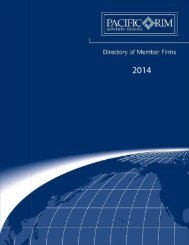A Guide to the Law of Securitisation in Australia - Clayton Utz
A Guide to the Law of Securitisation in Australia - Clayton Utz
A Guide to the Law of Securitisation in Australia - Clayton Utz
- No tags were found...
You also want an ePaper? Increase the reach of your titles
YUMPU automatically turns print PDFs into web optimized ePapers that Google loves.
6.3.3 General civil consequencesO<strong>the</strong>r civil penalties are provided for <strong>in</strong> <strong>the</strong> Code. For example, acredit provider’s failure <strong>to</strong> comply with certa<strong>in</strong> requirements <strong>in</strong>connection with a mortgage or guarantee can result <strong>in</strong> <strong>the</strong>mortgage or guarantee (or certa<strong>in</strong> provisions <strong>of</strong> such a document)be<strong>in</strong>g void or unenforceable.6.3.4 L<strong>in</strong>ked credit providerUnder <strong>the</strong> so called l<strong>in</strong>ked credit provider provisions <strong>of</strong> <strong>the</strong> Code,a credit provider can be held responsible for certa<strong>in</strong> actions andstatements made by a supplier <strong>of</strong> goods or services <strong>in</strong> connectionwith <strong>the</strong> credit contract and <strong>the</strong> sale contract, if <strong>the</strong>re is asufficient connection between <strong>the</strong> credit provider and thatsupplier.6.3.5 Unjust contractsPursuant <strong>to</strong> <strong>the</strong> Code, a court or tribunal can reopen <strong>the</strong>transaction that gave rise <strong>to</strong> an unjust contract, mortgage orguarantee (or an unjust variation). It can also annul or reducecerta<strong>in</strong> unconscionable fees.6.4 The credit provider <strong>in</strong>demnified for a breach <strong>of</strong> <strong>the</strong> CodeIn general, as a matter <strong>of</strong> public policy, <strong>the</strong> courts will not enforcea contract that provides for a person <strong>to</strong> be <strong>in</strong>demnified aga<strong>in</strong>stcrim<strong>in</strong>al, and arguably, civil penalties under a statute.This policy was <strong>of</strong> concern <strong>to</strong> trustees <strong>in</strong>volved <strong>in</strong> securitisationprograms and led <strong>to</strong> a submission by <strong>the</strong> Trustee CorporationsAssociation <strong>of</strong> <strong>Australia</strong> (TCA) <strong>to</strong> State and Terri<strong>to</strong>ry ConsumerAffairs M<strong>in</strong>isters <strong>in</strong> relation <strong>to</strong> <strong>the</strong> impact <strong>of</strong> <strong>the</strong> Code onsecuritisation. Clay<strong>to</strong>n <strong>Utz</strong> assisted <strong>the</strong> TCA <strong>in</strong> mak<strong>in</strong>g thatsubmission.This concern has now been largely overcome by section 169A <strong>of</strong><strong>the</strong> Code. That section provides as follows:“(1) An <strong>in</strong>demnity for any liability under this Code is not void, andcannot be declared void, on <strong>the</strong> grounds <strong>of</strong> public policy,despite any rule <strong>of</strong> law <strong>to</strong> <strong>the</strong> contrary.(2) The liabilities <strong>to</strong> which this section applies <strong>in</strong>clude <strong>the</strong>follow<strong>in</strong>g –(a) a liability for any crim<strong>in</strong>al or civil penalty <strong>in</strong>curred by anyperson under this Code;(b) a payment <strong>in</strong> settlement <strong>of</strong> a liability or alleged liabilityunder this Code;(c) a liability under ano<strong>the</strong>r <strong>in</strong>demnity for any liability underthis Code.(3) This section is subject <strong>to</strong> section 169(2).(4) This section does not derogate from any o<strong>the</strong>r rights andremedies that exist apart from this section.(5) This section extends <strong>to</strong> any <strong>in</strong>demnity obta<strong>in</strong>ed before <strong>the</strong>commencement <strong>of</strong> this section.”This section provides that an <strong>in</strong>demnity from any person for anyliability under <strong>the</strong> Code is not void on <strong>the</strong> grounds <strong>of</strong> public policy.Those liabilities are expressed <strong>to</strong> <strong>in</strong>clude both civil and crim<strong>in</strong>alpenalties, a payment <strong>in</strong> settlement <strong>of</strong> a liability or allegedliability under <strong>the</strong> Code, and a liability under ano<strong>the</strong>r <strong>in</strong>demnityfor any liability under <strong>the</strong> Code.6.5 Licens<strong>in</strong>g and registration requirementsThe Adm<strong>in</strong>istration legislation <strong>in</strong> Vic<strong>to</strong>ria, <strong>the</strong> <strong>Australia</strong>n CapitalTerri<strong>to</strong>ry and Western <strong>Australia</strong> requires providers <strong>of</strong> creditwhich is regulated by <strong>the</strong> Consumer Credit Code <strong>to</strong> be ei<strong>the</strong>rregistered or licensed.That legislation must be carefully reviewed <strong>to</strong> determ<strong>in</strong>e which<strong>of</strong> <strong>the</strong> parties <strong>in</strong>volved <strong>in</strong> a securitisation program need <strong>to</strong> be solicensed or registered.6.6 ConclusionWhere Code-regulated receivables are <strong>to</strong> be securitised, it isimportant, <strong>in</strong> light <strong>of</strong> <strong>the</strong> consequences <strong>of</strong> contravention, that<strong>the</strong>se comply with <strong>the</strong> Code <strong>to</strong> ensure <strong>the</strong> <strong>in</strong>tegrity <strong>of</strong> <strong>the</strong>relevant program. For this reason it is current practice for a Codecompliance sign-<strong>of</strong>f <strong>to</strong> be received by selected participants(<strong>in</strong>clud<strong>in</strong>g <strong>the</strong> rat<strong>in</strong>g agency) from a major law firm <strong>in</strong>volved with<strong>the</strong> securitisation.The next sections <strong>of</strong> this publication deal with two matterspr<strong>in</strong>cipally affect<strong>in</strong>g <strong>the</strong> participation by banks, build<strong>in</strong>g societiesand credit unions <strong>in</strong> securitisation – <strong>the</strong> <strong>Australia</strong>n PrudentialRegulation Authority requirements (section 7) and set-<strong>of</strong>f(section 8).43






